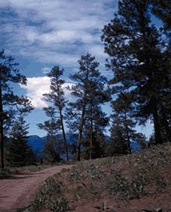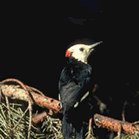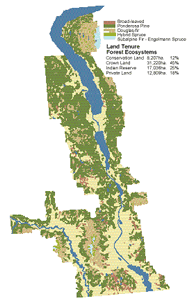|
(published
1998)
Habitat Atlas
for Wildlife at Risk
Forest Ecosystems
The South Okanagan and Similkameen valleys
have a diverse array of forests covering almost 44 percent
of the land area, from the lower treeline, where ponderosa
pines are scattered among the sagebrushes, up to the
alpine treeline, where mats of stunted spruce and fir
are twisted by cold mountain winds. Between these two
limits are relatively dry ponderosa pine and Douglas-fir
forests, somewhat wetter western larch forests at middle
elevations on the eastern side of the valley, and cool,
moist Engelmann spruce and subalpine fir forests on
the ridge tops and high plateaus.
This atlas is confined largely to forests
in the South Okanagan below approximately 1200 metres
in elevation. These low elevation forests are dominated
by ponderosa pine and Douglas-fir. These are relatively
dry forests, characterized by an open, park-like structure
with grassy understories. Indeed, the ground cover of
ponderosa pine forests is very similar to that found
in the adjacent grasslands and shrublands.
Forestry & Fire Management
 Since
the turn of the century, South Okanagan forests have
been harvested with increasing intensity. This harvest
has changed the structure of the forests. Old growth
forests were likely the dominant successional stage
before the turn of the century, but now make up only
23 percent of the forests in the area. Since
the turn of the century, South Okanagan forests have
been harvested with increasing intensity. This harvest
has changed the structure of the forests. Old growth
forests were likely the dominant successional stage
before the turn of the century, but now make up only
23 percent of the forests in the area.
Harvesting methods have changed significantly since
the early 1900s. Early logging operations removed large
ponderosa pine and Douglas-fir, leaving many mature
trees and dead snags, resulting in a forest that retained
most of its old-growth characteristics. While low elevation
logging still uses selection methods, most or all snags
are removed, resulting in a forest that cannot be used
by many species that require dead trees for nesting,
roosting or feeding. Old, large ponderosa pines, which
are associated with a number of endangered and threatened
bird species, became seriously depleted early in this
century.
 Selective
logging practices and fire suppression have resulted
in a dramatic change in the structure of low elevation
forests in the South Okanagan, from open, park-like
forests with scattered large trees to the present dense
stands of younger trees. With these changes in practices
and structure comes a change in fire regime. Fires were
once more frequent, smaller and cooler, but now are
less frequent, larger and more intense. The formerly
common, low-intensity fires are called stand-maintaining
fires, since they maintain an overstory of large, well-spaced
trees while clearing out shrubs, small trees and other
vegetation. Selective
logging practices and fire suppression have resulted
in a dramatic change in the structure of low elevation
forests in the South Okanagan, from open, park-like
forests with scattered large trees to the present dense
stands of younger trees. With these changes in practices
and structure comes a change in fire regime. Fires were
once more frequent, smaller and cooler, but now are
less frequent, larger and more intense. The formerly
common, low-intensity fires are called stand-maintaining
fires, since they maintain an overstory of large, well-spaced
trees while clearing out shrubs, small trees and other
vegetation.
 Fire
suppression policies over the last 50 years have dramatically
altered the fire return frequency, and most sites have
not been burned at all during that period. Many areas
are now characterized by a dense understory of shrubs
and small, regenerating trees. This dense growth excludes
many plant and animal species that require the open,
grassy understory typical of the natural forest. Fire
suppression policies over the last 50 years have dramatically
altered the fire return frequency, and most sites have
not been burned at all during that period. Many areas
are now characterized by a dense understory of shrubs
and small, regenerating trees. This dense growth excludes
many plant and animal species that require the open,
grassy understory typical of the natural forest.
Threats:
- Removal of dead standing snags used as nest holes.
- Low elevation forests may disappear with increase
residential and subdivision development on forested
slopes.
- Old growth trees, used as roosting, nesting and
denning habitat for birds and mammals, are subject
to logging pressure.
- Increased forest density has lowered habitat quality
for some species.
Wildlife at Risk for which Forest habitat is
critical:
Red List
|
Blue List
- Rubber Boa
- Gopher Snake
- Gray Flycatcher
- Townsend's Big-eared Bat
- California Big-horn Sheep
- Flammulated Owl
- Lewis's Woodpecker
|

|